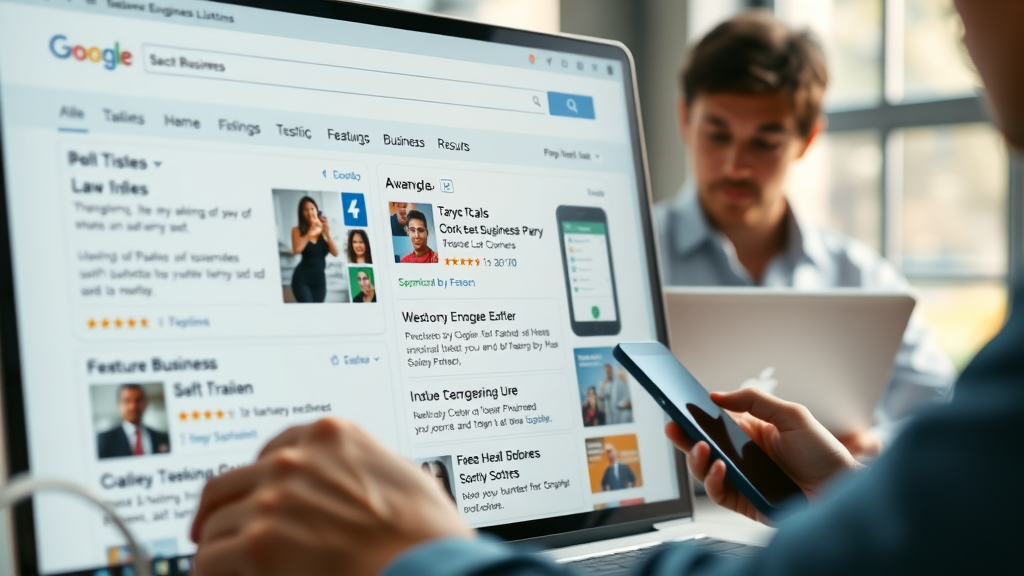Did you know that 46% of all Google searches are looking for local information? Mastering local SEO puts your business right in front of these eager customers.

Startling Facts: Why Local SEO Is a Game Changer for Local Businesses
If you own a business and haven’t tapped into local SEO, you’re missing out on a massive opportunity. Every day, thousands of potential customers use their phones to find local shops or services exactly like yours. In fact, it’s estimated that 78% of local mobile searches result in an offline purchase. This powerful statistic highlights why optimizing for local search results directly affects your bottom line. By focusing your SEO strategy on local intent, your business can appear at the top of search results when people are actively looking for products and services near them.
What makes local SEO so transformative is its ability to level the playing field. Large corporations might dominate national rankings, but a well-optimized Google Business Profile and consistent business info give small and medium businesses a fighting chance to be featured in the coveted local pack or on Google Maps. This increased visibility translates to more foot traffic, phone calls, and ultimately sales, making it an essential piece of modern digital marketing for local businesses of every size.
"Did you know that 46% of all Google searches are looking for local information? Mastering local SEO puts your business right in front of these eager customers."
What You’ll Learn About Local SEO
- Understand what local SEO really is
- How local SEO impacts business profiles and local ranking
- Step-by-step local SEO strategy for your business
- Key local SEO tools and tips for success
- How to optimize your Google Business Profile and appear in the local pack
Understanding Local SEO: The Basics Every Business Owner Should Know
What is Local SEO?
Local SEO means optimizing your online presence so your business appears in location-based searches, such as “coffee shop near me” or “best plumber in [your city].” Rather than competing at a national or global level, local SEO focuses on connecting you with nearby customers searching for your products or services. The most impactful place to appear is in Google’s local pack—the highlighted map listing shown for local queries—and on Google Maps results.
"Local SEO is about being visible for geographically-related searches, specifically within Google’s local pack and Google Maps results."
Unlike traditional SEO that aims for broad search results, local SEO helps customers discover accurate business info like your phone number, address, and business hours right when they need it. It’s an essential strategy for brick-and-mortar stores, service providers, and anyone who serves a specific area. When your local business ranks higher, more customers easily find and connect with you—right when they’re ready to buy.
The Importance of Local Search for Local Businesses
With local searches on the rise, a solid local SEO presence means you’re meeting customers exactly where they need you. Today, over 80% of people who conduct a local search visit a store within five miles—proving that strong local search visibility turns online discovery into in-person sales. Optimizing for local search is no longer optional for small businesses—it’s critical to compete and grow in your community.

Local SEO gives you the tools to accurately display your business name, address, phone number, and hours across platforms like Google Maps, Yelp, social media, and leading business directories. Keeping this info current builds consumer trust and increases the chance of appearing in the local pack—which directly brings more calls and visits. In an era when one customer review can shape buying decisions, local SEO ensures you’re not just visible, but credible and attractive to every potential local customer.
How Search Engines Rank Local Businesses
When someone searches for a business near them, search engines use a combination of location, relevance, and prominence to rank local businesses. Google’s algorithm considers signals like distance from the searcher, quality and consistency of business info, the number of customer reviews (and their recency), and how well your content matches the local keyword in the search. The more complete and accurate your Google Business Profile and other directory listings, the higher you’ll often appear in local rankings.
Fresh content, engagement (such as Google reviews), and frequent updates to your business listing all help signal to Google that your business is reputable and relevant. Links from local sources, as well as the proper use of local keywords on your website, further build trust. Ultimately, maintaining a robust, consistent online presence across platforms is a direct pathway to outshining competitors in both map and web-based local search.
Differences Between Local SEO and Traditional SEO
While both local and traditional SEO focus on increasing online visibility in search results, local SEO is specialized for location-based searches and features map placements. Traditional SEO targets broad keywords and global audiences, whereas local SEO prioritizes “near me” searches, business addresses, and proximity to the user. This means getting listed in the local pack and on Google Maps matters far more for local SEO than for traditional strategies.
Local SEO also emphasizes managing online reviews and ensuring that business info is synced across all platforms. Directory consistency, geo-targeted content, and local citations are must-haves in local SEO but are not always a focus of national SEO campaigns. For a small business owner, local SEO offers an invaluable way to rank higher in the places that truly matter—where customers live, search, and shop.
Local SEO and Your Business Profile: Why It Matters
Business Profile Optimization for Higher Local Ranking
Your business profile acts as your digital storefront—and the more robust and accurate it is, the better your chances to be seen. Whether it’s your Google Business Profile, Yelp listing, or local directories, detailed business info (name, phone number, hours, and services) helps search engines match your listing to relevant local searches. Photos, service descriptions, and up-to-date info directly influence local ranking and appeal to customers.
Maintaining a comprehensive business profile goes beyond a simple listing; it invites interaction through Google reviews, customer Q&A, and shares on social media. Frequent updates signal activity and reliability, causing search engines to feature you more prominently. The goal is to make every detail easily accessible so you become the immediate choice when customers see the local pack or check Google Maps.
Google Business Profile: Setting the Foundation
At the heart of all local SEO success is an accurate, fully optimized Google Business Profile. This essential tool helps your business appear on Google Search and Maps, directly influencing your local rank—often above traditional website listings. When someone finds your profile, they can instantly call, navigate to your store, or read recent reviews. Accurate categories, service menus, business hours, and high-quality images help distinguish your listing from competitors.

Setting up your Google Business Profile takes only minutes, but it’s crucial to keep it updated with changes to your phone number, product offerings, and hours—especially during holidays or special events. The more complete and verified your listing, the more Google trusts your business, which helps you rank higher and get noticed in the local pack and local search results.
Keeping Your Business Info Updated Across Directories
Consistency is the secret weapon for achieving top local rankings. Your business name, address, and phone number (“NAP”) should be identical across every online directory, social media profile, and business listing. Mismatches—even a small difference in spelling or formatting—can confuse both customers and search engines, potentially costing you local search visibility.
Dedicate time each month to auditing and updating all major business directories (Google Maps, Yelp, Bing Places, Apple Maps, Foursquare, and more). Adding local keywords to each listing and monitoring for fraudulent or duplicate listings builds trust and keeps your local SEO strong. Remember, using automation or an SEO tool to manage this process will save hours and improve your accuracy.
How Google Maps Impacts Local Rankings
Appearing prominently on Google Maps is a direct route to attracting new local customers. Google Maps integrates multiple signals—from reviews, proximity, and keyword relevance to profile completeness and engagement—to rank your business in search. Unlike traditional SEO, where your website plays the starring role, Google Maps puts your physical business location upfront, backed by ratings and reviews that influence buying decisions.
Keeping your maps listing updated with events, offers, and seasonal changes (plus photos and updated contact info) earns higher engagement and visibility. By focusing on local SEO and the intricacies of Google Maps, you ensure your business stands out in both mobile search and in-car navigation tools—critical for intercepting customers in real time as they decide where to spend.
The Local Pack and Local Search Results: Standing Out Where It Counts
What Is the Local Pack and Why Is It Essential?
The local pack is a special section at the top of Google’s search results that highlights three top local businesses relevant to the user’s query. Each listing displays the business name, ratings, reviews, hours, and a direct map link for navigation. For local businesses, showing up here is golden—it delivers massive visibility and captures high-intent searches, often outpacing even high-ranked organic website listings.

The goal of every local SEO strategy is to break into this three-business spotlight. Doing so means more clicks, calls, and walk-ins because you’re making it painfully simple for customers to choose you over competitors. The local pack dominates mobile screens, making it especially effective for quick searches while on the go.
Optimizing for the Local Pack in Search Results
To appear in the local pack, you need a fully optimized Google Business Profile, accurate business info, a regular stream of positive reviews, and strategic local keyword usage. Google favors actively managed businesses that update listings, encourage reviews, and engage with customer Q&A. Geographic proximity, completeness of your business info, and optimization for key local search terms all play essential roles.
Local citations on business directories, fresh photos, posts, and responses to both positive and negative customer reviews also improve your ranking in the local pack. Quality matters—encourage happy clients to leave meaningful feedback, keep content current, and use an SEO tool to monitor your position. These steps collectively demonstrate to Google that your business offers value and remains a trusted choice in local search results.
How to Get Your Local Business Featured in Google Maps and Local Pack
The path to local pack and Maps domination starts by claiming your business profile, verifying your location, and ensuring every field is filled out accurately. Upload plenty of high-resolution photos, add clear category tags (e.g., “pizza restaurant” or “emergency plumber”), and introduce well-researched local keywords into your descriptions. Make sure your phone number and website are correct.
Encourage each customer interaction to end with a review request—these reviews are a ranking signal that help you stand out from competitors. Consistently post updates, answer customer questions, and monitor your profiles for incorrect business info or spam. The more engagement and trust you build, the more likely you are to earn a top spot in both the local pack and Google Maps.
| Feature | Local Pack | Organic Results | Paid Ads |
|---|---|---|---|
| Visibility | High (top of search) | Moderate to High | Top/Bottom of search |
| User Intent | Immediate/local | Informational/commercial | Transactional |
| Cost | Free (optimization-based) | Free (optimization-based) | Pay-per-click |
| Trust Factor | High (reviews, NAP info) | Variable | Lower (ad disclaimer) |
| Conversion Rate | Very High | Moderate | Variable |
Step-by-Step Local SEO Strategy for Local Businesses
Step 1: Conducting Local Keyword Research
Identifying the right local keywords shapes your entire local SEO strategy. Start by putting yourself in your customers’ shoes—what would you search if you needed your own service nearby? Use SEO tools to analyze what people in your city, neighborhood, or area actually type into Google. Low-competition, highly relevant terms like “best [service] in [city]” help you gain targeted traffic and edge out competitors. Don’t forget to include variations with your location (e.g., street names, landmarks).

Once you’ve compiled a list, sprinkle those terms naturally throughout your website, service descriptions, business profile details, and posts. Consistent, thoughtful keyword targeting is a foundational step to rank higher not only in the organic results, but in Maps and the local pack.
Step 2: On-Page Optimizations for Local Search
To maximize your visibility in local search, your website needs local cues everywhere—page titles with location, schema markup for your address and contacts, geo-specific landing pages, and embedded maps. Use structured data markup (schema.org) to help search engines easily understand your local business info, services, and physical location.
Add your NAP and hours to your homepage and every landing page. Include location-based testimonials and feature neighborhood events or partnerships on your blog. Embedding a Google Map and cross-linking to your Google Business Profile enhances authority and helps convert searchers into customers quickly and efficiently.
Step 3: Citations, Business Directories, and Consistency
Submitting your business info to trusted local directories (Yelp, Yellow Pages, local Chamber of Commerce, etc.) earns “citations”—mentions of your business name, address, and phone that build authority with search engines. The key is consistency: every listing must have exactly the same details.
Duplicate or mismatched listings hurt local rankings, so periodically audit your citations and use an SEO tool to spot errors. The more authoritative the directory and the more aligned your details, the higher your local ranking will climb. This consistency also makes it easier for customers to find local businesses like yours.
Step 4: Generating Reviews to Build Trust in Search Results
Customer reviews are among the most powerful ranking signals in local SEO. The more positive, recent reviews your business earns on Google and other important directories, the more likely Google is to feature you in the local pack and on Maps. Encourage happy customers to leave feedback by following up post-purchase with a simple, polite request.

Monitor and respond to every review (good or bad). Engaging with feedback builds consumer confidence, demonstrates active management, and boosts your standing in search results. Over time, authentic reviews help you outrank competitors and attract new customers looking for trustworthy, high-quality local businesses.
Step 5: Monitoring Your Local Rank and Adjusting Your SEO Strategy
Knowing your exact local rank is vital for judging if your strategy is working. Use dedicated SEO tools to track your local positions in both the organic and map results for your top keywords. If you see a drop, review your business info, keyword use, and recent reviews to identify potential issues. Regular monitoring lets you catch changes, react quickly, and adjust your SEO strategy to maintain and improve your ranking.
Analyzing data monthly (at a minimum) helps you spot trends, discover which initiatives are driving success, and address any weak points before they erode your competitive advantage. A proactive review strategy—combined with SEO tool insights—ensures you never fall behind in the dynamic world of local search.
- Checklist: Essential Elements for Local SEO Success
- Claim and optimize your Google Business Profile
- Ensure business info is consistent everywhere
- Add local keywords to your website and directories
- Encourage and manage Google reviews
- Submit your site to leading business directories
- Optimize landing pages for local intent
- Track rankings with a reliable SEO tool
The Role of SEO Tools for Local SEO Success
Overview: Best SEO Tools for Local Businesses
SEO tools play a vital role in making sense of your website’s performance, keyword rankings, business info accuracy, and competition. Leading options for local businesses include Moz Local, BrightLocal, SEMrush Local, Whitespark, and Google’s own free SEO tools like Search Console and Google Analytics. Each tool provides unique features to streamline local SEO—from citation audits to review monitoring and keyword tracking.
Choosing the right mix of tools depends on your needs: larger businesses may want comprehensive suites, while smaller shops may only need a targeted solution to track their local search position or audit their business directory presence. Either way, letting these tools do the heavy lifting lets you focus more time on serving customers and less on manual data gathering.
How to Use an SEO Tool to Track Local Ranking
Successful local SEO means regularly checking where you appear in search for your target local keywords and business categories. Most premium SEO tools feature a “local rank tracker” that lets you input your priority terms and monitors your place in the results over time—including whether or not you’re in the coveted local pack or maps. The best tools also alert you to changes in ranking, gaps in your business info, or opportunities for new citations.

For starters, log in, set your main local keywords and business location, and review your top pages and competitors monthly. Use the analysis to adjust your SEO strategy—adding missing keywords, requesting more reviews, or fixing inconsistent citations. Efficient tracking gives you a competitive edge in constantly shifting search results.
Using SEO Tools to Monitor Search Results and Performance
A good SEO tool does more than rank tracking—a full-featured one shows backlink profiles, search visibility, citation status, and even competitor strategy. Use these insights to identify weaknesses in your current approach and spot winning tactics. Performance monitoring also includes keeping tabs on keyword trends, review volume and sentiment, and NAP consistency across directories.
SEO tools provide dashboards that visualize local search movement, letting you correlate traffic increases with your optimization efforts. Dive deep into geographic search coverage to see which neighborhoods or communities respond best to your business, then target content and promotions accordingly for even stronger local search results.
Integrating Multiple SEO Tools in Your Local SEO Strategy
Blending several SEO tools—such as Google Search Console, Google Analytics, and a premium local SEO platform—amplifies your ability to assess performance from all angles. Use one tool for citation management, another for reviewing your Google Maps visibility, and a third for tracking organic and map results over time. This comprehensive approach builds a robust local SEO strategy that adapts as your business grows and your digital landscape evolves.
Don’t overlook tools for social media management, local review alerts, and business directory audits—each feeds key ranking signals into your overall strategy. Integrated reporting lets you spot successes and issues at a glance and tweak your plan on the fly to stay ahead in local search.
| SEO Tool | Key Features | Pricing |
|---|---|---|
| Moz Local | Directory listings, NAP consistency, local ranking tracking | From $14/month |
| BrightLocal | Review management, citation audit, competitor tracking | From $29/month |
| SEMrush Local | Local keyword tracking, business profile optimization, analytics | From $20/month (add-on) |
| Google My Business/Analytics | Profile management, search and map insights, free tools | Free |
| Whitespark | Local citation finder, reputation builder | From $25/month |
Advanced Local SEO Tactics to Boost Your Local Search Results
Optimizing Local Keyword Targeting
Taking local keyword targeting to the next level involves diving into specifics—use neighborhood names, landmark references, and long-tail phrases unique to your area. Beyond city-level keywords, layer in precise service details and customer questions. Analyze your SEO tool’s keyword data to prioritize terms with the best balance of traffic and competition for your niche.
Refresh your keyword strategy quarterly, incorporating seasonal trends and new service offerings. Including these nuanced terms in your website, Google Business Profile posts, and directory listings helps expand the radius of your visibility and strengthens your place among top local businesses.
Leveraging Google Maps for Local Ranking
Your Google Maps presence isn’t passive—actively manage it by posting updates, sharing photos, highlighting special offers, and encouraging location check-ins. Regular engagement signals to Google that your business is both current and customer-focused, a major factor in local ranking.
Track how customers discover you—are they finding local businesses through direct search, branded search, or through a category? Use these insights to refine your business info and prioritize areas where you could outrank nearby competitors. Promptly respond to queries or complaints to showcase reliability and responsiveness.
Using Google Business Profile Posts to Enhance Your Business Profile
Take full advantage of Google Business Profile Posts—publish offers, event announcements, and product highlights directly to your profile. These posts appear in your business listing and even in Maps, driving fresh attention to what’s new. Each post should include a local keyword, strong call-to-action, and eye-catching image.
Actively posting not only keeps your listing engaging, but it’s also a positive signal in Google’s algorithms—businesses that use features regularly are deemed more relevant, which influences local ranking. Regular, value-packed updates keep your customers informed and motivate repeat visits.
Geo-Tagging Images for Local Search Optimization
Geo-tagging embeds your business’s physical location information into your website or Google profile images, further confirming your presence to search engines. When you upload new photos—whether storefront shots, products, or team activities—add geographic tags to reinforce your association with your target service area. Most modern phones and cameras embed this data automatically, but you can also use online tools to add location data.

Images with accurate geo-data appear more often in local image search results and enhance your Google profile. Over time, this gives search engines even more proof that you’re a “real world” business in your area, helping you climb the ranks in both the local pack and Google Maps.
Winning More Local Pack Spots with Strategic Content
Consistently publishing relevant, location-rich content on your website and Google Business Profile drives you closer to winning precious spots in the local pack. Focus on blog posts or landing pages about community events, local partnerships, or customer stories. The more targeted and unique your content, the better you’ll rank for long-tail local search queries.
Regular content updates (think weekly or bi-weekly) make your site an authoritative resource in your area, a factor that both users and search engines love. Don’t forget to share your best posts on social media and via entries on your business profile to maximize reach and engagement.
Common Mistakes with Local SEO—and How to Avoid Them
- Failing to Update Google Business Profile Consistently – An out-of-date profile loses trust and ranking power.
- Neglecting Local Keyword Research – Not targeting the right search queries keeps you invisible to locals.
- Ignoring Reviews in Search Results – Unmanaged reviews hurt credibility and search performance.
- Not Monitoring Local Ranking Regularly – Missed trends or ranking drops can let competitors leapfrog your position.
- Overlooking Mobile Optimization for Local Business – With most local searches on mobile, a clunky site loses customers instantly.
Tracking Your Local Rank: Measuring Success in Local SEO
Which Metrics Matter Most for Local SEO
Metrics to watch include your position in the local pack, Google Maps rankings for each target keyword, the number of business profile views, calls and requests for directions, total and average Google reviews, and website traffic from local search. Engagement numbers (Q&A activity, photo views, clicks) also highlight what’s working and what needs improvement.

Compare your stats monthly and seek increases in positive reviews, views, and clicked calls—these signal rising trust, search visibility, and real-world customer action. Drops may indicate technical issues, bad reviews, or lost relevance for important local keywords.
Using Google Analytics and Google Maps Insights
Google Analytics reveals how well your local SEO drives site visits and which landing pages perform best for your target audience. Google Maps Insights further show how many searches triggered your business, which keywords users typed, and what actions they took (calls, requests for directions, photo views). Use both to track conversion rates and see which optimization tactics actually produce in-store outcomes.
Together, these free SEO tools arm you with actionable intelligence to refine your local SEO strategy—spotting strong sources of new customers, high-performing services, and content gaps to fill. The more granular your evaluation, the better your long-term results.
How to Interpret Local Ranking Fluctuations
Local rankings often fluctuate due to factors like new reviews, changed business info, competitor updates, or Google’s algorithm shifts. Don’t panic over small day-to-day changes—focus on weekly and monthly trends. If you see a sudden drop, check for inconsistent data, negative reviews, or technical issues like a down website or broken links. Regularly updating and refining your strategy helps smooth out these bumps and builds long-term stability in local search.
When you notice major increases or decreases, compare your metrics to recent changes: did you earn new reviews, gain backlinks, or make edits to your profiles? Such insights help you identify which efforts genuinely move the needle so you can invest where you get maximum return.
Adjusting Your Local SEO Strategy Based on Data
Use your findings from analytics and ranking tools to refine your SEO approach. Shift your keyword targeting to match emerging search trends, resolve business info discrepancies, or increase focus on platforms where you see the most engagement. Routinely soliciting customer feedback also surfaces improvement opportunities or service gaps you can fix to win more search and real-world business.
Never set and forget—local SEO is dynamic, so a flexible SEO strategy driven by real data will always keep your business ahead of local competitors and top-of-mind with potential customers.
Resources: Business Directories, SEO Tools, and Local SEO Communities
Top Business Directories for Improved Local SEO
Get your business listed on high-authority directories: Google Maps, Bing Places, Yelp, Apple Maps, Facebook, Yellow Pages, Angie’s List, and local Chamber of Commerce pages. These directories validate your business info to search engines, grow your digital footprint, and generate valuable citations that boost your ranking.
Specialty directories—like home services or restaurant guides—can be particularly effective if available in your industry. Keep listings identical and ensure your website links and reviews are active on each.
Online Communities for Staying Ahead in Local Search
Join forums and groups like Local Search Forum, Google Business Profile Community, and relevant subreddits. Here you'll learn firsthand about Google updates, algorithm changes, and emerging best practices from fellow local business owners and SEO experts. These communities are a rich source of case studies, troubleshooting, and quick tips to stay competitive.
Most importantly, you can get specific advice or feedback about your listings, on-page tactics, and outreach strategies, helping you continually refine your local SEO efforts.
Free and Paid SEO Tools to Boost Your Local Rank
For free solutions, start with Google Analytics, Google Search Console, and your Google Business Profile dashboard. For more sophisticated needs, invest in paid SEO tools like Moz Local, BrightLocal, or Whitespark for directory, listing, keyword, and review management. Some tools auto-update your business info across directories, saving valuable time and reducing human error.
Blending these tools gives you a 360-degree view—track rankings, discover new keyword ideas, audit competitors, monitor reviews, and get alerts on changes to your status in the local pack. A small monthly investment in the right tools brings a substantial return in greater visibility and sales.
Outsourcing Local SEO: Agencies vs. DIY
Not every business owner can (or should) manage every detail themselves. If local SEO feels overwhelming, agencies offer comprehensive services—listing management, review outreach, on-page optimization, and analytics. DIY is more affordable and builds internal know-how but requires ongoing time and attention. Assess your budget, skills, and available hours honestly when deciding.
If you do outsource, choose an agency experienced with your local area and industry. Check their client results and look for transparent, educational communication styles—they should explain what they’re doing and why at every stage.
People Also Ask: Decoding Top Questions on Local SEO
What does local SEO mean?
Local SEO means optimizing your online presence so your business shows up when people search for nearby products, services, or businesses. It’s about making sure customers can find you on Google Maps, in the local pack, and in location-specific search results whenever they need you most.
Is doing a local SEO worth it?
Absolutely. With more than half of mobile searches intending to find a local business and so many ending in real-world purchases, investing in local SEO pays off with more visibility, calls, visits, and sales. It helps level the playing field with large competitors and gets your business in front of people ready to buy.
How much does local SEO cost in the US?
Local SEO costs vary by provider and need. DIY business owners can get started for free with basic tools, or invest $30–$100/month in third-party platforms. SEO agencies may charge anywhere from $500 to $2,500+ per month for full-service local SEO management, including content, citations, review outreach, and ongoing optimization.
What is the difference between local SEO and normal SEO?
Local SEO is geared toward optimizing your business for location-based searches—so you show up in map listings and for “near me” queries. Traditional (normal) SEO chases general keywords and broad audiences; local SEO focuses on ranking your business within a specific city, neighborhood, or region by optimizing your profiles, website, and directory listings for local customers.
FAQs About Local SEO for Business Owners
How does local SEO affect my Google Business Profile?
Local SEO keeps your Google Business Profile prominent in both map and regular search results. The better your optimization (keywords, photos, reviews, business info), the more likely Google is to place your listing high in local packs and Maps, leading directly to more views, calls, and visits.
What are quick wins for local ranking improvements?
Verify your Google Business Profile, correct NAP inconsistencies across directories, ask for more reviews from happy customers, and post updates or photos weekly. Address any negative reviews quickly and keep your site mobile-friendly for instant local search success.
How can I track my position in the local pack?
Use SEO tools like BrightLocal, Moz Local, or Whitespark’s local rank tracker to monitor where your business appears for your main keywords in both the local pack and Maps. These tools help you measure improvement, spot sudden drops, and track your local SEO ROI over time.
Do online reviews really impact my local SEO?
Yes! Both the quantity and quality of online reviews influence your ranking in Google’s local pack and search results. Consistent, positive reviews signal trust and relevance, while unanswered complaints or negative patterns can drop your business lower or even exclude you from top local spots.
What are the best free SEO tools for local businesses?
Start with Google My Business (now Google Business Profile), Google Analytics, and Google Search Console. These offer robust, no-cost insights into search performance, user engagement, and optimization opportunities for local businesses.
Key Takeaways: What Every Local Business Should Remember About Local SEO
- Local SEO is essential for visibility in local search results
- Optimizing your business profile and Google Business Profile is critical
- SEO tools help measure, track, and enhance your local ranking
- Consistent information and positive reviews boost your local business
Conclusion: Why You’ll Never Go Back After Mastering Local SEO
Unlocking the magic of local SEO transforms your business—bringing more customers to your door and making your business a local favorite. Start today, apply these strategies, and watch your local visibility soar.
Set Your Business Up To Suceed: Make An Appointment To Learn How to Optimize AI Tools In Your Business
To deepen your understanding of local SEO and its impact on businesses, consider exploring the following resources:
-
Local SEO: The Complete Guide by Ahrefs offers a comprehensive overview of local SEO strategies, including optimizing your Google Business Profile and building local citations.
-
What is local SEO? Guide to ranking in local search results by Search Engine Land provides insights into how local SEO works and its importance for businesses aiming to attract local customers.
These resources will equip you with actionable strategies to enhance your local search visibility and connect effectively with your community.
 Add Row
Add Row  Add
Add 



Write A Comment